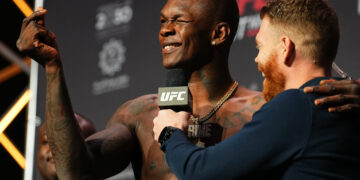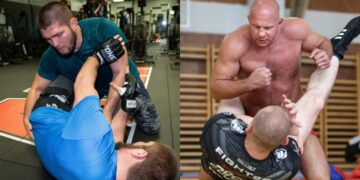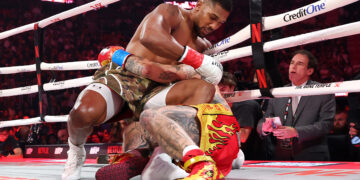
Wrestling has become an increasingly integral part of BJJ, particularly in the No-Gi ruleset, where grips on the Gi are absent, and the style is more explosive. Incorporating wrestling techniques into your No-Gi BJJ game can significantly enhance your ability to control and dominate opponents, especially in the standing phase of the match. In this article, here are seven essential wrestling concepts that every No-Gi BJJ practitioner should master.
1) Head Control
In wrestling, controlling the opponent’s head is often said to control the entire body. This concept is equally important in No-Gi grappling. The head is like the steering wheel of the body; wherever the head goes, the body follows. By controlling the opponent’s head, you can manipulate their posture, balance, and ability to attack.
Head control can be established in various ways, such as through collar ties, headlocks, or even hand positioning. For example, a strong collar tie allows you to pull the opponent’s head down, making them more susceptible to takedowns like snap-downs or throws. Additionally, maintaining head control can prevent your opponent from executing their takedowns or submissions, giving you the upper hand in exchanges.
To improve your head control, practice drills that focus on maintaining strong ties and positioning. Ensure that your movements are fluid and that you can switch between different types of head control seamlessly. Over time, this will make your overall grappling game stronger.
2) Hip Control
Hips are the center of power and balance in grappling, and controlling the opponent’s hips is crucial for both offense and defense. In wrestling, hip control allows you to dictate the pace and direction of the match; regardless of what you want to accomplish, controlling the opponent’s hips is critical.
In No-Gi BJJ, hip control becomes even more significant because the absence of grips makes it harder to control the opponent’s body using their clothing. Techniques such as body locks, underhooks, and overhooks are essential tools for gaining hip control. For instance, a well-executed body lock can restrict the opponent’s hips, preventing them from sprawling or escaping, thereby setting up high-percentage takedowns.
Improving hip control requires not just strength but also a solid knowledge of leverage. Drills emphasizing pummeling, hip throws, and control from the top position can greatly enhance your ability to dominate your opponent’s hips.
3) Alignment
Alignment refers to the proper positioning of your body relative to your opponent’s, ensuring that your head, shoulders, and hips are in line. Good alignment allows you to maximize your power and efficiency in both offensive and defensive techniques.
In No-Gi BJJ, maintaining proper alignment is essential when executing takedowns, sweeps, or submissions. For example, when attempting a double-leg takedown, your head and hips should be aligned with the direction of the drive to maximize the force and reduce the risk of counterattacks. Similarly, in guard passing, staying aligned with your opponent’s hips and shoulders can help you maintain pressure and prevent them from recovering guard.
To develop a better sense of alignment, practice techniques slowly and focus on the mechanics of your body positioning. Working with a knowledgeable instructor or training partner who can provide feedback will also help refine your alignment and overall technique.
4) Inside Position
A term made popular by John Danaher, the concept of inside position refers to maintaining your arms or legs inside your opponent’s center of mass. This position is advantageous because it gives you more control over your opponent’s movements and access to their core, making it easier to apply pressure or execute attacks.
In wrestling, the inside position is often sought during tie-ups, where having inside control of the opponent’s arms can lead to better leverage for takedowns or throws. In No-Gi BJJ, the inside position is important during clinch work, guard passing, and even submission attempts. For example, when pummeling for underhooks, gaining inside control allows you to dictate the clinch, making it easier to secure a dominant position or initiate a takedown.
To develop a strong inside game, practice pummeling drills and focus on maintaining control of the inside space during sparring sessions. This will help you become more proficient in controlling and countering your opponent’s movements.
5) Pressure And Weight Distribution
One of the key principles of wrestling that translates exceptionally well into No-Gi BJJ is the use of pressure and proper weight distribution. Applying consistent pressure on your opponent forces them to carry your weight, which can be physically exhausting and mentally taxing. This pressure often leads to openings for submissions or positional advances.
In No-Gi Jiu-Jitsu, pressure can be applied in various ways, such as when passing guard, securing a top position, or executing a submission. Proper weight distribution ensures that your opponent is constantly struggling to breathe, move, or defend, making it easier for you to maintain control and capitalize on mistakes.
To master pressure and weight distribution, practice techniques that involve heavy top control, such as side control, mount, or knee on belly (KOB). Focus on making small adjustments to your position to increase the discomfort for your opponent while maintaining a stable base.
6) Timing
Timing is a crucial aspect of wrestling, especially in No-Gi BJJ, where speed and precision can make the difference between success and failure. The ability to recognize the right moment to execute a technique can significantly increase your effectiveness on the mats.
Wrestling drills often emphasize reaction time, teaching athletes to respond quickly to their opponent’s movements. This skill is essential in No-Gi BJJ, where the lack of grips means that opportunities can appear and disappear in an instant. By honing your timing and reaction, you can anticipate your opponent’s actions and counter them effectively.
To improve timing, incorporate reaction drills into your training routine. These can include live takedown drills, positional sparring, or flow rolling, where the focus is on responding to your opponent’s movements rather than forcing techniques.
7) Aggressiveness
Wrestling is known for its high intensity and aggressive style, which can be highly effective in No-Gi BJJ. Pushing the pace and maintaining a high level of activity can overwhelm opponents, forcing them to make mistakes or exhaust themselves. This aggressive approach can be particularly useful in competitions, where matches are often won by those who control the tempo.
Incorporating wrestling’s aggressive mindset into your BJJ game means constantly looking for opportunities to attack, whether through takedowns, guard passes, or submissions. It also involves staying relentless in your pursuit of control, always seeking to advance your position or create openings.
To develop this aggressive approach, train with a focus on conditioning and maintaining a high pace during sparring sessions. Work on your mental toughness, and push yourself to stay active even when tired. Over time, this will become a natural part of your game, making you a more formidable opponent.
Conclusion
By adding these seven essential concepts into your No-Gi Jiu-Jitsu training, you can significantly enhance your grappling skills and overall effectiveness on the mats. These are all critical components that will help you dominate your opponents, whether in training or competition. Remember that mastering these concepts requires consistent practice, attention to detail, and a willingness to push beyond your comfort zone.
You may also like:
Craig Jones: The Polarizing & Elite Australian Grappler
Brazilian Jiu-Jitsu is a martial art known for its seemingly endless options to submit the opponent. One of the more unorthodox ways to tap someone is by using the bicep slicer. Although less commonly discussed…
Craig Jones, a name synonymous with BJJ and BJJ’s meme culture, is a grappler who has established himself as a household name in more ways than one. Hailing from Australia, Jones has become one of…
Brazilian Jiu-Jitsu is more than just a martial art or a sport; it is a community rich with tradition and etiquette. Practicing BJJ involves adhering to certain etiquette rules that ensure a positive environment for…
BJJ’s popularity has increased exponentially in the past three decades thanks to the growth of mixed martial arts. It’s a fun martial art to train regardless of your fitness level, and it’s an effective self-defence…
If you train in Brazilian Jiu-Jitsu, you will surely encounter opponents of various sizes and skill levels. One of the unique challenges for larger (or even medium-sized) grapplers is dealing with smaller and faster opponents….
Congratulations on your decision to dive into the world of Brazilian Jiu-Jitsu (BJJ)! Get ready for many fun rolling sessions as you learn some of the cool submissions you’ve seen on TV and make many…
Interim ONE Featherweight Kickboxing World Champion, Superbon, has risen to the top of the global kickboxing rankings with a unique brand of Thai-styled kickboxing. His unorthodox methods, developed in Bangkok’s elite stadiums and mastered through…
Whether you’re seeking a new way to stay fit, a method for enhancing personal discipline, or a reliable means of self-protection, martial arts can be a rewarding and practical pursuit. However, navigating the martial arts…
Chuck “The Iceman” Liddell is one of the most legendary figures in mixed martial arts history and one of the founders of the sprawl-and-brawl style that brought an end to the utter domination grapplers, particularly…
Thai Superstar, Superlek Kiatmoo9 was in an intriguing position after defeating former Bantamweight Muay Thai World Champion, Jonathan Haggerty, and claiming his belt in the first round of their highly anticipated bout at ONE 168:…
Wanderlei César da Silva, aka “The Axe Murderer,” is one of the most feared strikers in mixed martial arts history and one of the first to showcase how effective Muay Thai could be. A product…
ONE Championship fans were disappointed in January when one of the most anticipated bouts of the year; a clash between Muay Thai legend, “The Iron Man,” Rodtang Jitmuangnon, and Japanese Kickboxing phenomenon, Takeru Segawa, at…




































